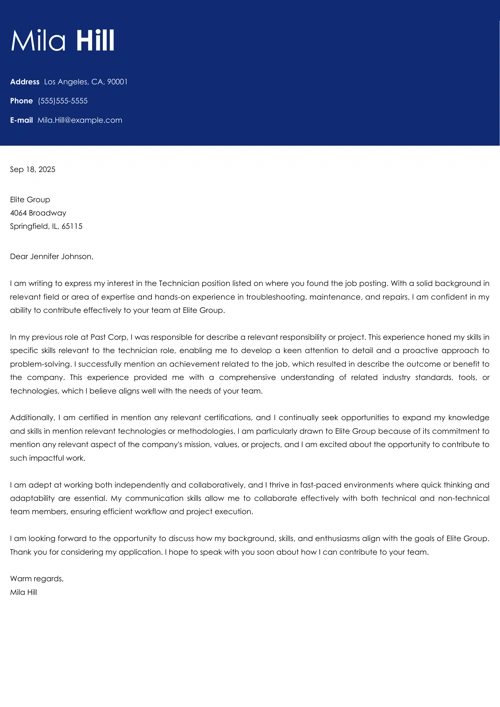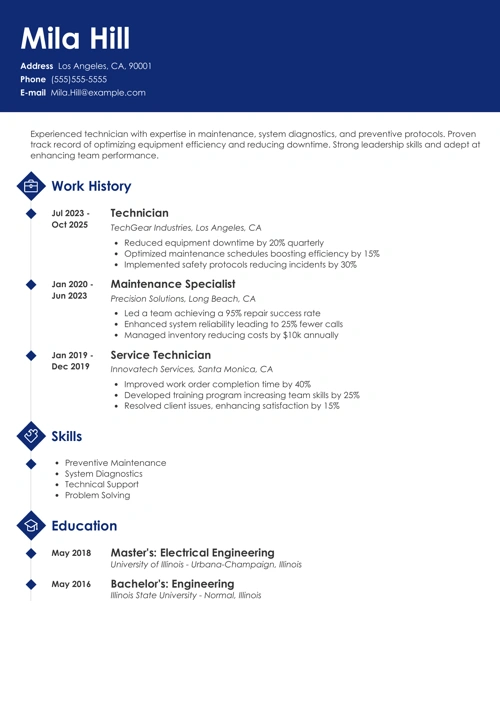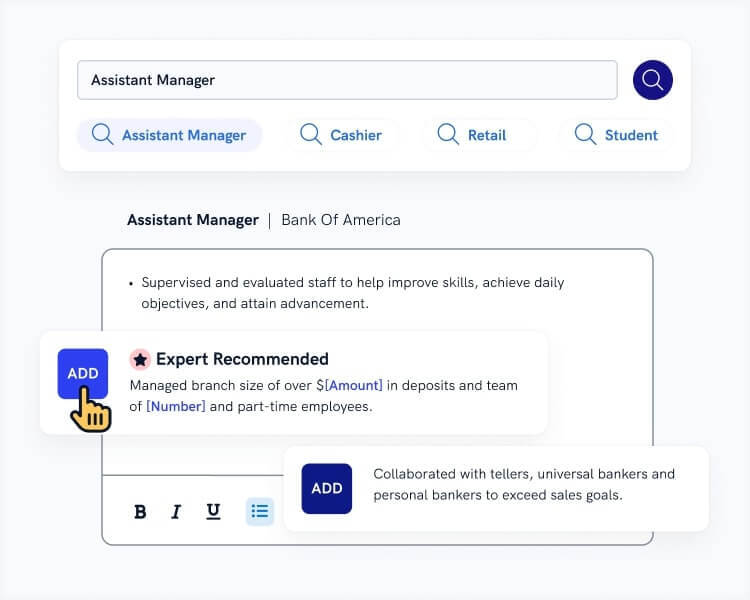What to include in a cover letter besides a desperate plea to give you a job? Cheer up! Writing one will be a breeze if you know what should be in a cover letter. Not only that—you’ll write an attention-grabbing cover letter that will get employers on the phone ASAP.
So, what should a cover letter include? Our brief cover letter guide will show you what should and shouldn’t be in a cover letter and why.
This guide will tell you:
- What to include in a cover letter to land your desired job.
- What goes into a cover letter.
- What are the essential parts of a cover letter.
- What NOT to include in a cover letter.
Want to save time and have your cover letter ready in 5 minutes? Try our cover letter builder. It’s fast and easy to use, and you'll get tips and right-vs-wrong examples while writing it. Choose from 20+ professional cover letter templates that match your resume.
Here’s an infographic showing you what to include in a cover letter:
Sample cover letter for a resume—See more cover letter examples here.
Looking for some cover letter examples? See:
- The Perfect Cover Letter for Any Job (Example & Guide)
- General Cover Letter Example
- Brief Cover Letter Example
- Cover Letter with No Experience Example
- Motivational Statement Example
- 5 Short Cover Letter Examples for Any Job (+ Writing Guide)
- Cover Letter for an Internship: Example & Tips for All Interns
- Business Cover Letter: Samples, Proper Format, & Writing Guide
- Cover Letter Examples to Land Any Job
Need a detailed cover letter writing guide? Check here: How to Write a Cover Letter in 8 Simple Steps.
Now, let’s see what should be in a cover letter to make it successful:
What to Include in a Cover Letter?
The key to writing a successful job application is to know exactly what to put in a cover letter. Are you wondering: "What should I include in a cover letter?" With a good writing guide, it’s just like following a cooking recipe. Think of each element of a cover letter as the necessary ingredients and your writing style as seasoning that adds a unique flavor.
Here are the key elements of a good cover letter:
Cover Letter Header
The cover letter header is one of the first parts of a cover letter that the hiring manager sees, so you need to get it right.
Your cover letter header should include:
- Your contact information—including your name, email address, and phone number. Your mailing address, branding statement, and link to your optimized LinkedIn profile are nice-to-haves.
- Current date—insert the date and place of writing.
- Company information—you need to list the name of the person leading the recruitment process, their job title, and the company address. Research the company website or go to a site like Glassdoor to locate the hiring manager’s name so that you can address your cover letter correctly.
Pro Tip: Keep it professional—no emails like “fancypants77@yahoo.com”. Also, ensure that the contact information in your cover letter header matches that in your resume.
Cover Letter Salutation
Start this cover letter section with a professional greeting, preferably including the employer's name. “Dear” is regarded as one of the best cover letter salutations out there, as it’s helpful whether the letter is formal or informal and whether you know the recruiter’s name.
Avoid cliché greetings such as Dear Sir or Madam or To Whom It May Concern, as they’re considered lazy and outdated. Try to find the hiring manager’s name in the job ad or do an internet search.
Read more: What to Write Instead of “To Whom It May Concern” in a Cover Letter.
Opening Paragraph (“The hook”)
This part of a cover letter is intended to hook the hiring manager’s attention and reel it right in.
Don’t start off with the fact that you’re applying for the open job position—they already know that. Instead, show your enthusiasm for the job by including attention-grabbing facts about the company or your respect for their products and services. A bit of praise can get you very far!
Use your cover letter introduction to showcase a couple of big work achievements or professional experiences that will impress the recruiter to continue reading. Mention that you want to use your experience and professional skills to help drive the company forward or solve its problems.
Middle Paragraph(s) (“Make an Offer”)
This is the most difficult of the cover letter components, but if you use the job ad as a cheat sheet, it will be much easier to explain how your skills and experience can benefit them.
Show them you’re the perfect fit for the company and team by mentioning your professional achievements. Give specific examples of using the required skills in the past. This section of your cover letter shouldn’t be a repetition of your resume but a tailored demonstration of your expertise.
For example, are they seeking an experienced, friendly retail sales associate? Tell them how you’ve been in that role for the last 3 years, consistently maintaining a 95% customer satisfaction rate.
Use moderation when talking about your professional achievements. Nobody likes a windbag.
Add bullet points and numbers to make your offer really stand out. Avoid overly long sentences and blocks of text. This isn’t an essay writing contest.
Closing Paragraph (“Call to Action”)
Write an impressive closing paragraph of your cover letter by briefly summarizing everything. Use this part of your cover letter to make the recruiter realize they want to call you. This is also the part of the cover letter where you thank the hiring manager for their time. Don’t forget to add a call to action by proposing a meeting or a phone call to discuss your fit to the team and the benefits for the company.
Show your enthusiasm right from the start! Begin your coveAlways end on a strong note! Close your cover letter with a confident call to action, expressing your eagerness to discuss how your skills can benefit the company. A positive, proactive conclusion leaves a lasting impression and encourages the hiring manager to reach out.r letter by expressing genuine excitement about the role and the company. A passionate opening sets a positive tone and can immediately grab the hiring manager's attention.
Sign-off and Your Name
Use a professional cover letter sign-off such as “sincerely” or “kind regards.” Avoid closings that are too informal, such as “cheers” or “thanks.”
Type out your full name. Leave some space below to either sign your name if you have a printed cover letter or for an electronic signature if you’re emailing your cover letter. Don’t forget about your cover letter enclosure at the very end. It’s especially helpful if the hiring manager requires several documents in your job application.
Postscript
A P.S. at the bottom of your cover letter always draws the reader’s attention, even if they don’t care to read the rest. Include an original idea for the company, or show off an impressive professional achievement in a way that will make them want to learn more about you.
Now that you know what should be included in a cover letter make sure to fill each element correctly. Remember what your cover letter should say: you can help the company succeed!
Read more: Remember to format your cover letter professionally. Use easy-to-read cover letter fonts that can make a good impression on recruiters. Set the spacing and margins of your cover letter to maintain a good balance between text and white space, and limit the cover letter length to one page. Learn more about cover letter formatting: Formatting a Cover Letter Step-by-Step.
What Should Be in a Cover Letter: Example
Adalynn Harris
Customer Service Representative
123 Seaside Lane
Portland, Maine, 04101
123-456-7890
adalynnharris@email.com
linkedin.com/in/adalynn-harris7136
Portland, March 1, 2024,
Emersyn Campbell
Human Resources Manager
LumeTech
456 Tech Boulevard
Portland, Maine, 04102
Dear Ms. Campbell,
I am writing to express my interest in the advertised Customer Service position at LumeTech. With my proven track record of exceptional customer service during my tenure at ThriveSwift, I am confident I can contribute to LumeTech's renowned customer satisfaction ratings.
At ThriveSwift, I led the implementation of a new customer relationship management system, increasing customer satisfaction scores by 25% within the first quarter of its launch. This achievement underlines my commitment to driving customer-centric improvements and showcases my ability to identify and address our client's needs proactively.
My motivation to join LumeTech stems from your commitment to innovation and focus on providing outstanding customer experiences. I want to bring my excellent communication skills, problem-solving abilities, and a customer-first mindset to support LumeTech's continued growth. My expertise and ability to work well in a team will greatly benefit your company.
I would appreciate the opportunity to meet with you to discuss how my skills and experiences align with LumeTech's goals and how I can contribute to maintaining the high standards of customer service that your company is known for.
Thank you for considering my application. I look forward to contributing to LumeTech.
Sincerely,
Adalynn Harris
Creating a resume with our builder is incredibly simple. Choose a resume template and follow our step-by-step guidance to have a professional resume ready in minutes.
When you’re done, Zety’s resume builder will score your resume and our ATS resume checker will tell you exactly how to make it better.
What Not to Include in a Cover Letter?
Maybe you’ve got a unique idea about what to include in a cover letter for a job. It’s better to check if it’s not against the rules. There’s always a bit of freedom in writing a job application, but going too far won’t make a good impression on recruiters. Here’s what not to put in a cover letter:
Irrelevant Information
Your cover letter should include relevant experience that fits the advertised position. Skip anything that won’t matter to the hiring manager.
Extensive Paragraphs
A cover letter is not an essay! Keep the paragraphs up to 5 sentences long to write a killer cover letter.
False Claims
It’s the same as in a resume—lying on a job application is a big NO. If you claim something, make sure you have facts to back it up.
Salary Expectations
Generally, it’s better not to include them. Mention your salary requirements in the cover letter only if the job advertisement tells you to do it.
Negative Remarks About Previous Jobs
Never say you hated your job. Whatever the circumstances of leaving a previous position are, keep all remarks professional.
Excuses
If you need to explain something in your cover letter, ensure you’re not using unverifiable claims, such as: “I didn’t get a promotion because the manager chose someone who slept with the boss.”
Personal Information
Unless it’s relevant to the position or the job advertisement, don’t focus on details of your personal life. The recruiter doesn’t need to know everything about you. In fact, providing irrelevant information may lead to unconscious bias and employment discrimination.
Social Links
Leave the socials, profile URLs, and portfolio to your resume unless the cover letter template of your choice has a place for them.
Excessive Flattery
You don’t need to be like, “I love you guys!”. Show your enthusiasm for the job, but don’t go too far with flattery. Focus on the company's achievements rather than subjective opinions about it.
Your Wishes
It’s perfectly fine that you expect certain things from the company. But in your cover letter, focus on saying what you can do for them.
Spelling or Grammar Errors
It’s just common sense—use a spellchecking tool such as Grammarly to ensure you don’t make any mistakes.
Wrong Names
It’s obvious, but make sure that you address the letter to the right company and person.
Strange File Name
Naming a cover letter is important. You don’t want the file lost on the recruiter’s hard drive. Always put your name and the position you apply for in the file name.
Remember that a cover letter should be formal. Unless you’re certain that the company culture is extremely relaxed, don’t include jokes or puns.
Read more: Indulge in the wealth of tips on writing a cover letter that will let you stand out: 35+ Successful Cover Letter Tips, Advice.
Plus, a great cover letter that matches your resume will give you an advantage over other candidates. You can write it in our cover letter builder here. Here's what it may look like:
See more cover letter templates and start writing.
Key Takeaway
Here's what should a cover letter include:
- Opening paragraph—grab the recruiter's attention with relevant skills and accomplishments.
- Middle paragraphs—show that you’re a perfect match and how you can add value to the company.
- Compelling ending—ask for a meeting or a call and add a catchy postscript.
About Zety’s Editorial Process
This article has been reviewed by our editorial team to make sure it follows Zety's editorial guidelines. We’re committed to sharing our expertise and giving you trustworthy career advice tailored to your needs. High-quality content is what brings over 40 million readers to our site every year. But we don't stop there. Our team conducts original research to understand the job market better, and we pride ourselves on being quoted by top universities and prime media outlets from around the world.




